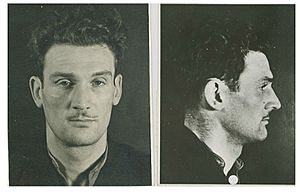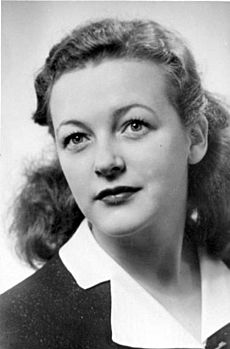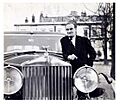Eddie Chapman facts for kids
Quick facts for kids Eddie Chapman |
|
|---|---|

Chapman in December 1942
|
|
| Allegiance | |
| Active | 1943–1945 |
| Operation(s) | Damp Squib |
| Fritz, Fritzchen | |
|
|
|
| Birth name | Arnold Edward Chapman |
| Born | 16 November 1914 Burnopfield, County Durham, England |
| Died | 11 December 1997 (aged 83) St Albans, England |
| Spouse | Betty Farmer |
| Children | 2 |
Edward Arnold Chapman (born November 16, 1914 – died December 11, 1997) was an English spy during World War II. He was known for his exciting and risky life. At the start of the war, he offered to work as a spy for Nazi Germany. But he secretly became a double agent for Britain.
The British Secret Service gave him the codename Agent Zigzag. This name showed how unpredictable his life had been. The Germans called him Fritz, and later Fritzchen, because they liked him.
Contents
Early Life and Adventures
Eddie Chapman was born in Burnopfield, England, on November 16, 1914. His father was a former marine engineer who later ran a pub. Eddie was the oldest of three children.
Even though he was smart, Eddie often skipped school. He preferred to go to the cinema or hang out at the beach.
At 17, Chapman joined the Coldstream Guards, a part of the British Army. He enjoyed wearing the uniform but quickly got bored. After nine months, he left the army without permission. He was later caught and spent some time in a military prison. After this, he was officially removed from the army.
Chapman then worked different jobs, like a barman or a film extra. But he often spent more money than he earned. He got into trouble with the law several times. He even spent time in prison for various minor offenses.
In 1938, Chapman was arrested in Scotland. He later escaped to Jersey in the Channel Islands. He was caught there and sent to a Jersey prison. This prison sentence, ironically, kept him safe when the Germans invaded the Channel Islands.
Becoming a Wartime Spy
Chapman was still in prison when the Germans took over the Channel Islands. While in jail, he decided to offer his services to the Germans. He wrote a letter in German, pretending to be a willing spy.
The Germans believed him and moved him to Paris. There, he was trained to be a German spy. He learned about explosives, radio communication, and how to parachute. His mission was to go to Britain and cause damage.
On December 16, 1942, Chapman was flown to Britain in a German bomber. He had a radio, a pistol, and money. His main task was to damage the de Havilland aircraft factory in Hatfield. This factory made important planes like the Mosquito.
However, the British secret service, MI5, already knew about Chapman. They had intercepted German messages. They planned to capture him and turn him into a double agent. But Chapman made it easy for them. Soon after landing, he gave himself up to the local police. He immediately offered to work for MI5.
MI5 decided to use him. They assigned Ronnie Reed to be his handler, helping him with his missions.
Faking the Factory Attack

MI5 and Chapman worked together to trick the Germans. On January 29, 1943, they faked an attack on the de Havilland factory. They made it look like Chapman had successfully damaged the factory.
German spy planes took photos of the site. The fake damage convinced Chapman's German bosses that his mission was a success. To make the story even more believable, MI5 even had a fake news story published in a British newspaper.
After this, MI5 wanted Chapman to return to his German contacts. They sent radio messages asking for him to be picked up. But the Germans were slow to respond. They told Chapman to go to Lisbon, Portugal, instead. This was difficult because he had no good reason to travel there.
Adventures in Portugal and Norway
MI5 wanted Chapman to go back to the Germans to gather important information. They gave him a list of questions to memorize. These questions were carefully chosen so that if he was caught, the Germans wouldn't learn what the Allies didn't know.
To get him to Lisbon, Chapman joined the crew of a merchant ship. Once in Lisbon, he met with German agents. He even suggested a plan to blow up the ship with a bomb disguised as a lump of coal. This was a trick to get samples of German explosives for the British. He handed the bombs to the ship's captain.
The Germans didn't realize the ship wasn't damaged. To keep their trust, the British made a big show of investigating the ship when it returned. This made sure the Germans heard gossip that the attack had been real.
Chapman was then sent to German-occupied Norway. He taught at a German spy school in Oslo. After a meeting with his German handler, Stephan von Gröning, Chapman was given the Iron Cross. This was a German military award, given to him for supposedly damaging the de Havilland factory and the City of Lancaster ship. This made him the first Englishman to receive such an award since 1871. He was also given a lot of money and his own yacht.
An MI5 officer noted that the Germans grew to like Chapman. But Chapman was mostly interested in adventure and his country. While in Oslo, he secretly took photos of other German agents.
Reporting on V-1 Bombs
After the D-Day landings in 1944, Chapman was sent back to Britain. His new mission was to report on how accurately the German V-1 flying bombs were hitting their targets.
He parachuted into Cambridgeshire on June 29, 1944, and went to London. He consistently told the Germans that the bombs were hitting central London. But in reality, they were falling short. Because of this false information, the Germans never corrected their aim. Most bombs landed in the southern suburbs of London or the countryside, causing less damage.
MI5 eventually decided they could no longer control Chapman. He was dismissed from his service on November 2, 1944. He received a payment from MI5 and was allowed to keep some of the money the Germans had given him. He was also pardoned for his actions before the war.
Personal Life

During the war, Chapman had two fiancées at the same time. One was Freda Stevenson in Britain, and the other was Dagmar Lahlum in Norway. While in Norway, he told Dagmar that he was a British agent. Luckily, Dagmar was connected to the Norwegian resistance. They then worked together to gather information from the Germans.
After the war, he left both women. He married his former girlfriend, Betty Farmer, whom he had left in Jersey years before. They had a daughter named Suzanne in 1954. Dagmar Lahlum was imprisoned for a short time after the war for being with a German officer. She couldn't prove that Chapman was a British agent. They met again briefly in 1994.
Life After the War
After the war, MI5 worried that Chapman might get into trouble again. He did get involved in some illegal activities, like smuggling gold in 1950. However, former intelligence officers often spoke up for him, confirming his important help during the war.
Chapman wrote about his wartime experiences. His book, The Eddie Chapman Story, was published in 1953. He also helped write the autobiography of Eric Pleasants, a British citizen who joined the Germans during the war.
Later in life, Chapman and his wife opened a health farm. They also owned a castle in Ireland. Chapman remained friends with Stephan von Gröning, his former German handler. Von Gröning even attended Chapman's daughter's wedding.
Eddie Chapman passed away from heart failure on December 11, 1997. He was survived by his wife Betty and his daughter.
Images for kids
See also
 In Spanish: Eddie Chapman para niños
In Spanish: Eddie Chapman para niños



